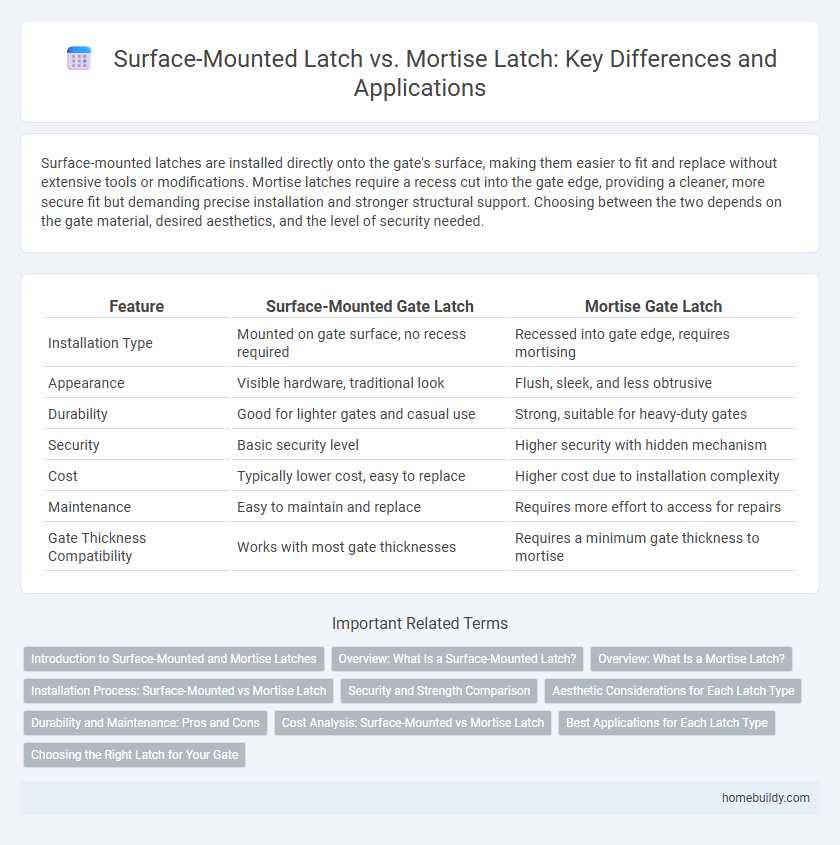Surface-mounted latches are installed directly onto the gate's surface, making them easier to fit and replace without extensive tools or modifications. Mortise latches require a recess cut into the gate edge, providing a cleaner, more secure fit but demanding precise installation and stronger structural support. Choosing between the two depends on the gate material, desired aesthetics, and the level of security needed.
Table of Comparison
| Feature | Surface-Mounted Gate Latch | Mortise Gate Latch |
|---|---|---|
| Installation Type | Mounted on gate surface, no recess required | Recessed into gate edge, requires mortising |
| Appearance | Visible hardware, traditional look | Flush, sleek, and less obtrusive |
| Durability | Good for lighter gates and casual use | Strong, suitable for heavy-duty gates |
| Security | Basic security level | Higher security with hidden mechanism |
| Cost | Typically lower cost, easy to replace | Higher cost due to installation complexity |
| Maintenance | Easy to maintain and replace | Requires more effort to access for repairs |
| Gate Thickness Compatibility | Works with most gate thicknesses | Requires a minimum gate thickness to mortise |
Introduction to Surface-Mounted and Mortise Latches
Surface-mounted latches attach directly to the surface of a door, providing easy installation and maintenance without requiring door modification. Mortise latches fit into a pocket cut within the edge of the door, offering enhanced security and durability due to their concealed installation. Choosing between surface-mounted and mortise latches depends on factors such as door material, security needs, and aesthetic preferences.
Overview: What Is a Surface-Mounted Latch?
A surface-mounted latch is a type of gate latch installed directly onto the surface of a gate or door, offering easy installation without the need for extensive carpentry. Unlike a mortise latch, which requires cutting a pocket within the gate or door edge, surface-mounted latches provide a simpler retrofit solution ideal for wooden or metal gates. These latches are commonly used for their durability and straightforward operation, making them suitable for residential and commercial gate security.
Overview: What Is a Mortise Latch?
A mortise latch is a type of locking mechanism designed to be recessed into the edge of a door, offering a flush and secure installation compared to surface-mounted latches that attach directly onto the door surface. Commonly used in commercial and residential applications, mortise latches provide enhanced strength and durability due to their integration within the door structure. This design allows for compatibility with various door hardware, including handles and deadbolts, improving overall security and aesthetic appeal.
Installation Process: Surface-Mounted vs Mortise Latch
Surface-mounted latches offer a straightforward installation process requiring only surface attachment with screws, making them ideal for quick upgrades or retrofits on existing doors. Mortise latches demand a more intricate installation, involving precise routing of a pocket within the door edge to house the latch mechanism, suitable for heavy-duty and security-focused applications. The choice between these latches depends on factors like door type, installation time, and the desired level of structural integration.
Security and Strength Comparison
Surface-mounted latches offer quick installation but generally provide less security and strength compared to mortise latches, which are embedded within the door, creating a more robust locking mechanism. Mortise latches feature reinforced metal components and deeper engagement with the door frame, enhancing resistance to forced entry and tampering. For high-security applications, mortise latches are preferred due to their superior durability and structural integrity.
Aesthetic Considerations for Each Latch Type
Surface-mounted latches offer a sleek, minimalist appearance as they are visibly attached to the door's exterior, enhancing modern design aesthetics with clean lines and simple installation. Mortise latches, embedded within the door, provide a seamless and traditional look that preserves the door's surface integrity while allowing for intricate handle and lock designs. Choosing between these latch types depends on balancing visible hardware appeal against maintaining classic door aesthetics.
Durability and Maintenance: Pros and Cons
Surface-mounted gate latches generally offer easier installation and maintenance due to their external positioning, but they are more exposed to weather elements which can reduce durability over time. Mortise latches are embedded within the gate, providing enhanced protection from environmental factors and increased durability, though they require more complex installation and occasional internal maintenance. Choosing between the two depends on balancing the need for durability against the convenience of maintenance.
Cost Analysis: Surface-Mounted vs Mortise Latch
Surface-mounted latches generally cost less than mortise latches due to simpler installation and reduced labor time, making them cost-effective for many applications. Mortise latches, while more expensive upfront, offer enhanced durability and security, often justifying their higher price in commercial or high-traffic settings. Evaluating total costs requires factoring in installation complexity, maintenance expenses, and long-term security benefits associated with each latch type.
Best Applications for Each Latch Type
Surface-mounted latches excel in applications requiring quick installation and easy maintenance on gates with flat surfaces, commonly used in residential garden fences and lightweight aluminum gates. Mortise latches provide superior security and durability, ideal for heavy-duty wooden or metal gates in commercial or industrial settings where embedded hardware offers enhanced strength and tampering resistance. Selecting the appropriate latch type depends on gate material, desired security level, and installation complexity.
Choosing the Right Latch for Your Gate
Surface-mounted latches offer easy installation on gate surfaces without requiring complex cutouts, making them ideal for wooden or metal gates where preserving structural integrity is crucial. Mortise latches require a pocket or recess carved into the gate edge, providing a more secure and flush fit, often preferred for heavy-duty or high-security applications. Selecting the right latch depends on gate material, desired security level, and installation preferences to ensure durability and functionality.
surface-mounted latch vs mortise latch Infographic

 homebuildy.com
homebuildy.com